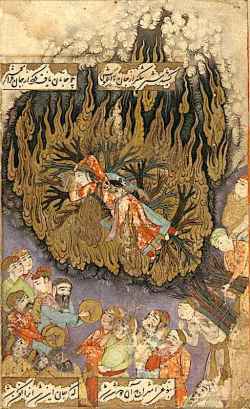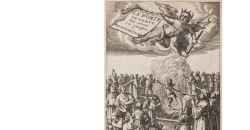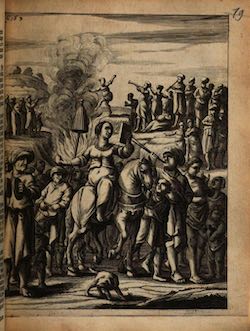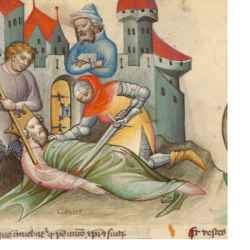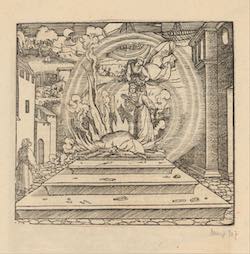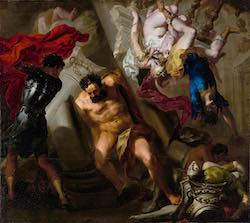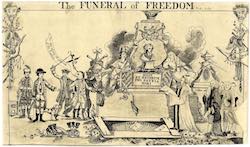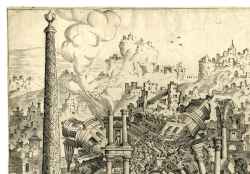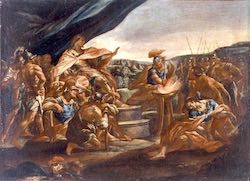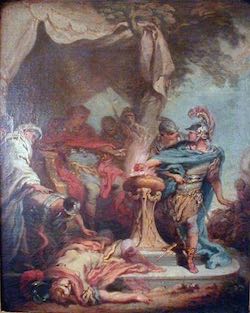Keyword: Self-Sacrifice
Satī. The bride immolates herself on the funeral pyre (1657)
from: Isfahan, Iran
The Israel Museum, Jerusalem
Scene of a Sati, with a woman throwing herself into the flames amid a crowd playing trumpets. Above, a winged devil holds the banner with the book's title and the torch with which he lights the ritual fire. (1670)
from: Abraham Rogerius, Le Théâtre de l’idolatrie ou la porte ouverte, Amsterdam, Jean Schipper, 1670, title page
Scene of a sati. In the foreground, a widowed woman (encountered by Della Valle on November 12, 1623) on horseback holds a mirror and a lemon amidst a crowd. In the background, a woman throws herself into the flames of a funeral pyre (1665)
from: Della Valle, Pietro, De volkome beschryving der voortreffelijke reizen van de deurluchtige reisiger Pietro della Valle, edelman van Romen, in veel voorname gewesten des werrelts, sedert het jaer 1615, tot in 't jaar 1626 gedaan. Amsterdam, Abraham Wolfgang, 1666, vol. 5, pag. 163
Self-sacrifice of King Codrus of Athens (1432)
from: Speculum humanae salvationis, Madrid, Biblioteca Nacional de España, Ms Vit. 25-7 (olim B. 19), fol. 24r
Biblioteca Nacional de España, Madrid
Suicide of a Woman on an Altar (1532)
from: Francesco Petrarca, Von der Artzney bayder Glück, des guten vnd widerwertigen: unnd weß sich ain yeder inn Gelück und Unglück halten sol; auß dem Lateinischen in das Teutsch gezogen, Augspurg, Steyner, 1532, p. clviii
Rijksmuseum Amsterdam
The Death of Samson [1650]
Getty Center, Museum East Pavilion, Los Angeles
The Funeral of Freedom (1769)
British Museum, London
Venerable María del Refugio Aguilar Torres (portrait) (20th Century)
Real Monasterio El Puig De Santa María, Order of Mercy. El Puig, Valencia (Spain)
(1670)
from: La Saincte Bible, Contenant le Vieil and la Nouveau Testament, Enrichie de plusieurs belles figures/Sacra Biblia, nouo et vetere testamento constantia eximiis que sculpturis et imaginibus illustrata, De Limprimerie de Gerard Jollain
Two dissertations: the first on the supposed suicide of Samson; wherein the part he bore in his own death is vindicated from the imputation of self-murther; and the nature and heinousness of that crime are fully set forth; the second, on Jepththa's vow, wherein is proved that his vow was fulfilled, and his daughter not sacrificed
London: William Innys - Jonathan Richardson, 1754.
Samson and Delilah, beyond Samson forces two columns and causes the temple to collapse; (1553)
from: Martinus . Hemskerck. Inventor / Hieronimus. Cock. excud. 1553
The British Museum, London
Samson Destroying the Temple of the Philistines (XVII)
Venezia, Museo Correr ( cl.III 1443)
What self-immolation means to Afghan women
in: Peace Review, v. 23 (2011), issue 1: pp.45-51.
in: Burning Women Widows, Witches, and Early Modern European Travelers in India, pp.
New York: Palgrave Macmillan, 2003.
Women in India: The “Sati” and the Harem
in: India in Early Modern English Travel Writings, pp. 209-238
Leiden: Brill, 2012.
Multiple Meanings of Buddhist Self-Immolation in China: A Historical Perspective
in: Revue d'Etudes Tibétaines, v. 25 (2012), issue : pp.203-212.
Mucius Scevola in front of Porsenna (18th Century)
Musée de l’Hôtel Sandelin, Saint-Omer

